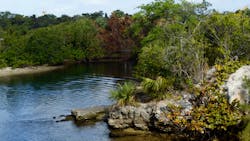The journey from potable water to wastewater can be very short when you consider the distance between a faucet and drain.
The water resource-recovery trip is much longer. Where water is scarce, shortening the return leg of that water drop’s trip and making the most of every drop through reuse is crucial. Water managers in water-scarce regions increasingly rely on reclamation, purification, fit-for-purpose treatment, aquifer replenishment, and/or other practices to accelerate the water cycle.
Throughout the United States – especially in arid regions – water scarcity has been a primary driver for water reuse. In some states, water quality concerns more often drive reuse decisions. But the need to develop a bigger or more resilient water supply to meet demand is increasingly a driver for many communities. If you are ready for a cross-country tour, I will point out what is happening in some states.
I started my career in Florida in the 1980s, when water agencies became very aware of the impact of discharge of nutrient laden wastewater to Florida’s warm and slow-moving surface water bodies. There was a push to provide either water reuse or nutrient removal through advanced wastewater treatment. Many utilities chose water reuse, and the projects implemented in that era resulted in Florida recycling more water today, according to state water managers, than any other state in the United States.
Water supply benefits of reuse were considered ancillary in Florida then; with the exception of a few coastal areas impacted by saltwater intrusion, Florida’s fresh groundwater resources were perceived as limitless. That changed in the 1990s when it became clear that the cost of continued pumping was lowering the surficial aquifer water table – drying up wetlands, lowering lake levels, reducing flows in Florida’s treasured springs, and accelerating saltwater intrusion. Today, water availability is a more-frequent driver for water reuse, leading many utilities throughout the state to adopt or consider potable reuse.
About a year ago, Florida’s governor signed “Reclaimed Water” Senate Bill 64 into law. That law calls for statewide elimination of non-beneficial surface water discharges of effluent by the year 2032 and encourages implementation of potable reuse. This encouragement combined with current activity to develop potable reuse regulations leads many to believe that reuse in Florida will continue to expand, with both effluent disposal and water availability continuing to serve as drivers.
Water scarcity was the initial driver for reuse in California, so the state has developed a robust reuse framework of programs focused largely on solving water-supply shortages. Largely, but not solely. Many utilities and communities in California today meet myriad needs through water recycling programs that not only enhance water supplies and resilience but also meet needs related to saltwater intrusion, ocean discharge, and/or other issues. Pure Water San Diego, Pure Water Soquel, and Orange County’s Groundwater Replenishment System and subsequent expansions are but a few examples of indirect potable reuse (IPR) programs that yield multiple benefits. While Florida may have more reuse than any other state, California wins the prize for the most IPR.
Arizona is another state that wrestles with water scarcity. Communities there have also implemented reuse, albeit not on the same scale as California and Florida. Potable reuse projects are in the planning, and some communities have long applied advanced treatment to reclaim and reuse water for non-potable applications such as watering golf courses and meeting industrial needs. Challenges with brine management have impeded large-scale implementation of potable reuse in Arizona.
In 2013, a drought in Texas brought water scarcity to the forefront. Big Springs and Wichita Falls became the first communities in the United States to launch direct potable reuse (DPR) projects. These projects dissolved or morphed into IPR projects when the rains came, but the situation opened eyes to reclaimed water as a drought-resistant alternative water supply. Other communities, such as El Paso, are eying potable reuse as means to meet future needs.
Water scarcity is not the only driver for reuse, and it continues to take a back seat to other factors in some locales. But California, Florida, Arizona, and Colorado are all actively developing rules for DPR and IPR to facilitate use of reclaimed water to meet water supply shortfalls, and two-thirds of the water-industry stakeholders surveyed for Black & Veatch’s 2022 Water Report expect new treatment processes to be added to their reuse facilities to increase resilience of their water supplies.
As climate change exacerbates droughts – and resilience becomes more important in planning for the future – I envision water scarcity wearing a chauffeur’s cap more often.
About the Author
Jo Ann Jackson
One Water national practice leader for Black & Veatch
Jo Ann Jackson P.E., is the One Water national practice leader for Black & Veatch. She can be reached at [email protected].

